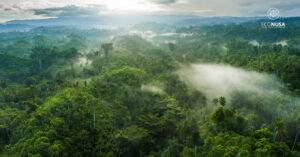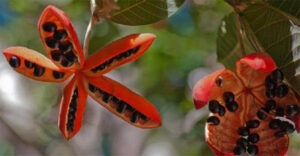
Kristian Sauyai has toured a number of islands in the Raja Ampat Islands, Raja Ampat Regency, West Papua Province. He went to Kri Island and Gam Island. There, he found the conditions of many homestays were damaged because they did not receive adequate care. He also encountered similar conditions when visiting other homestays on different islands.
“80 percent of homestays were damaged. Most vulnerable, damage occurs on the roof of the homestay, “Kristian said when contacted by EcoNusa.
Kristian is the chairman of the Raja Ampat Indigenous People and Business Activists Association (Perjampat), an umbrella organization for indigenous Papuans (OAP) homestay owners in Raja Ampat. Perjampat was founded in 2009. Starting with eight homestays on the islands of South Waigeo, Kri, and Gam, now Perjampat members have reached 133 homestays spread across every island in Raja Ampat.
The initiative to form Perjampat was based on the spirit of independence. Before Perjampat was founded, local people did not have a significant place in managing the tourism business in Raja Ampat. Lodging and other accommodations are mostly managed by foreigners and migrants. One of the reasons behind the formation of Perjampat is due to the closure of information on homestays that are managed by local communities rather than resorts owned by foreign nationals.
Time passes and the attraction of Raja Ampat never lasts for tourists. In the last five years, the number of tourists visiting Raja Ampat has never decreased. On the contrary, it continues to increase. According to the publication of the Central Statistics Agency of Raja Ampat Regency, 10,759 foreign tourists (tourists) and 7,691 domestic tourists (wisdom) visited Raja Ampat in 2014. The number of visits increased to 24,090 foreign tourists and 22,285 wisdom in 2019.
But 2020 is an exception. The COVID-19 pandemic that has hit various regions of the world is forcing everyone to postpone travel to prevent the spread of the virus. As a result, various sectors of the service industry were significantly affected, including tourism. Since March 2020, Raja Ampat has been deserted without tourists. The Raja Ampat Regency Government temporarily closed all tourist destinations through Circular No. 440/101 / Setda dated March 22, 2020.
Without visitors, there is no economic transaction and the income will be nil. On the other hand, homestays that are made using environmentally friendly building materials still need maintenance.
“There is no final cost (homestay) is not maintained. Until the end of the year, the homestay guest booking schedule is canceled. But there were also guests who were concerned about this situation and then contributed money to the homestay. There are also those who change the schedule until next year, “said Kristian.
During the COVID-19 pandemic, the people of Raja Ampat survived by relying on garden produce to meet food needs. They also protect the surrounding sea from the practice of exploiting marine resources irresponsibly. According to Kristian, this pandemic situation is being used by certain groups to catch fish and damage the environment in the dive spots.
Kristian heard the news that tourism in Raja Ampat will slowly reopen in August 2020. Unfortunately, there is not much that Perjampat can do to help each member’s needs.
“I had time to sit down with my friends (Perjampat). I tell my friends, at least we can socialize the new standard operating procedures that we will use at the opening of tourism, “said Kristian.
What happens in the waters of Raja Ampat is not much different from the conditions of tourist destinations in the mountains. Bird watching destinations in the Arfak Mountains, West Papua Province, have been forced to bite their fingers to face pandemic conditions. As with tours in Raja Ampat, previously booked visit schedules are canceled until the end of the year.
“All booking schedules from June to December are canceled. There is also no next year. If they cancel to be changed to next year, okay. But they have no news for next year, ”said Hans Mandacan, a bird watching and homestay ecotourism manager in Kwau Village.
Hans said that the damage to the homestay in the Arfak Mountains occurred in five villages, namely Kwau, Syoubri, Maibri, Warmarway, and Mupi Gunung villages. The five villages are well-known among bird watchers as excellent destinations that are worth a visit. Cenderawasih collar (Lophorina superba) or in the local language called nyet, Cenderawasih Astrapia Arfak (Astrapia nigra), and Cenderawasih Parotia Arfak (Parotia sefilata) are endemic birds that tourists can find in the Arfak Mountains.
So, it’s no wonder big names in bird research like Tim Laman, a wildlife photographer, and Ed Scholes, a bird researcher from the United States-based Cornell Lab of Ornithology, have ever set foot there. But now there are no guests who fill out the list of homestay visits.
Papua Lorikeet, Hans’s homestay, generated IDR 250 million in 2019. If there was no COVID-19 pandemic, from June to December Hans should have earned IDR 500 million.
“But all cancel and there will be no income like that for this year,” said Hans.
Tour guides and local people spend their time gardening to survive. They grow taro, banana, corn and sweet potato.
“Because of the corona disease we are hungry this year, but we are planting today, we will eat next year. Half dead,” said Hans jokingly.







